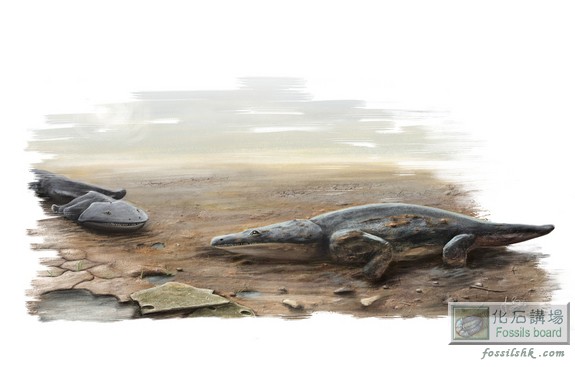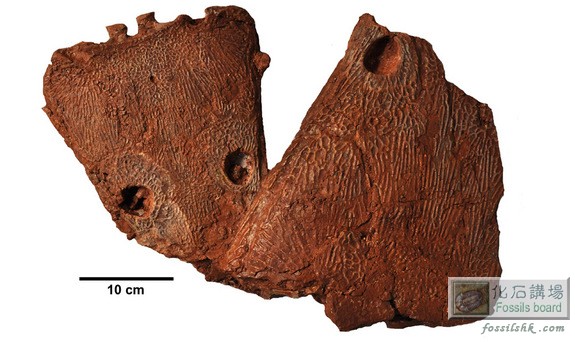fossilshk
(Lung)
管理員
  








UID 1
精華
23
積分 4775
帖子 2827
閱讀權限 200
註冊 2006-7-14
來自 中國/香港
狀態 離線
|
[廣告]:
Car-Size Salamander with Toilet-Seat Head Ruled Ancient Rivers
A small-car-size "super salamander" with a toilet-seat-shaped head may have perished some 220 million to 230 million years ago alongside hundreds of its kin when its lake home dried up, researchers say.
An international team of scientists found several skulls and various other bones — including those of the arm, shoulder and backbone of the amphibian, now called Metoposaurus algarvensis — in an ancient lake bed in southern Portugal. From these bones, the researchers determined that the creature was a new species of metoposaurid, an extinct group of large amphibians.
"Most modern amphibians are pretty tiny and harmless. But back in the Triassic, these giant predators would have made lakes and rivers pretty scary places to be," study co-author Richard Butler, of the University of Birmingham in the United Kingdom, said in a statement.
Digging for treasure

The team uncovers fossils of the new amphibian, now called Metoposaurus algarvensis, from the Algarve region in southern Portugal, where a gradulate student, Thomas Schroeter, in the late 1970s to early 1980s found speciments possibly from the same group of amphibians. The researchers relocated this bonebed in 2009, where they have found nearly 10 different skulls and several other bones from this newfound species.
From beyond the grave

Here, a model of the Metoposaurus algarvensis amphibian, a member of the metoposaurids, which had yet to be found on the Iberian Peninsula. The creature, which was equipped with hundreds of sharp teeth and a big, broad head (like other metoposaurids) would have filled crocodile-like predator niches when alive.
A peak into the past

This artist's conception highlights the flat "toilet-seat-shaped" head of Metoposaurus algarvensis, as co-researcher Steve Brusatte of the University of Edinburgh describes it. The beast would have swung its flat head around to snag fish in the rift valleys on the supercontinent Pangaea.
Digging for history

Brusatte uncovers some of the bones of Metoposaurus algarvensis at their dig site. Hundreds of these creatures may have died at once when their lakebed dried up, leaving behind a jackpot of bones for paleontologists to discover. The rest of their kin, along with most metoposaurids and half of the planet's species, went extinct around 201 million years ago. That mass extinction at the end of the Triassic is thought to have paved the way for the rise of dinosaurs.
What a large mouth it had...

The lower jawbone of the recently uncovered Metoposaurus algarvensis. Various features distinguished this animal from other metoposaurids, including some differences in the brain region, the lower jaw and openings for nerves and the spinal cord. Though it would not have been any match for the larger dinosaurs and mammals, some of the smaller land dwellers likely stayed clear of the giant amphibian, the researchers speculated.
More fossils

The shoulder girdle bones of the newly discovered Metoposaurus algarvensis. The animal's puny limbs suggest that while it was a good swimmer, it was likely pretty awkward on land, Brusatte said.
A huge find

The skull of the newfound amphibian Metoposaurus algarvensis. The researchers have excavated just a small portion of the bonebed and hope to continue digging there, where they expect to find even more bones like this one.
Unusual bones

Part of the Metoposaurus algarvensis amphibian's palate and skull.
Evidence uncovered

Skulls of the Metoposaurus algarvensis discovered together at the site in Portugal.
http://www.livescience.com/50225 ... amander-photos.html
| 
 |
|



